Monterey Bay
Monterey Bay is a bay of the Pacific Ocean located on the coast of the U.S. state of California. The bay is south of the major cities of San Francisco and San Jose. Santa Cruz is located at the north end of the bay, and Monterey is on the Monterey Peninsula at the south end. The "Monterey Bay Area" is a local colloquialism sometimes used to describe the whole of the Central Coast communities of Santa Cruz and Monterey counties.
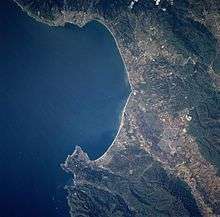
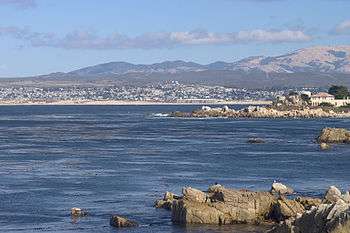
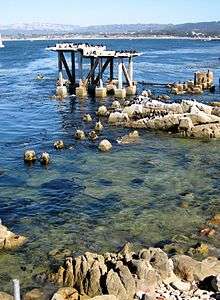
Toponymy
The first European to discover Monterey Bay was Juan Rodríguez Cabrillo on November 16, 1542, while sailing northward along the coast on a Spanish naval expedition. He named the bay Bahía de los Pinos,[1] probably because of the forest of pine trees first encountered while rounding the peninsula at the southern end of the bay.[2] Cabrillo's name for the bay was lost, but the westernmost point of the peninsula is still known as Point Pinos.
On December 10, 1595, Sebastián Rodríguez Cermeño crossed the bay and bestowed the name Bahía de San Pedro in honor of Saint Peter Martyr.[2][3]
The present name for the bay was given in 1602 by Sebastián Vizcaíno, who had been tasked by the Spanish government to complete a detailed chart of the coast. He anchored in what is now the Monterey harbor on December 16, and named it Puerto de Monterrey, in honor of the Conde de Monterrey, then viceroy of New Spain.[1] Monterrey is an alternate spelling of Monterrei, a municipality in the Galicia region of Spain from which the viceroy and his father (the Fourth Count of Monterrei) originated.
All other place names in the vicinity containing Monterey were so named because of their proximity to the bay. This includes the Presidio of Monterey, City of Monterey, County of Monterey and Monterey Canyon.
Geology
The Monterey Canyon, one of the largest underwater canyons in the world, begins off the coast of Moss Landing, in the center of Monterey Bay. It is 249 miles (401 km) long, although its shape changes regularly because of currents and sediment being left in the area. The canyon is much like that of a continental slope; the biology of the canyon changes significantly in different parts of the canyon.[4]
Flora and fauna
Monterey Bay is home to many species of marine mammals, including sea otters, harbor seals, and bottlenose dolphins; as well as being on the migratory path of gray and humpback whales and a breeding site for elephant seals. Killer whales are also found along the coast, especially when Gray whales migrate, as they hunt the whales during their migration north. Many species of fish, sharks, mollusks such as abalone and squid, birds, and sea turtles also live in the bay. Several varieties of kelp grow in the bay, some becoming as tall as trees, forming what is known as a kelp forest.
Marine protected areas
Soquel Canyon State Marine Conservation Area, Portuguese Ledge State Marine Conservation Area, Pacific Grove Marine Gardens State Marine Conservation Area, Lovers Point State Marine Reserve, Edward F. Ricketts State Marine Conservation Area and Asilomar State Marine Reserve are marine protected areas in Monterey Bay. Like underwater parks, these marine protected areas help conserve ocean wildlife and marine ecosystems.
Communities around Monterey Bay


Clockwise around the bay, generally from north to south. Inland communities are indented:
- Santa Cruz
- Capitola
- Aptos
- Rio del Mar
- La Selva Beach
- Moss Landing
- Castroville
- Marina
- Seaside
- Monterey
- New Monterey
- Pacific Grove
- Carmel
- Carmel Valley
- Carmel Highlands
Gallery
- Monterey Bay seen with the old Cannery Foundations
- One of many beaches along the Monterey Bay coast line
 Monterey Bay as seen from Soquel, California. The Moss Landing power plant is visible in the distance.
Monterey Bay as seen from Soquel, California. The Moss Landing power plant is visible in the distance.- Scuba diving lessons in the bay, near Monterey, California
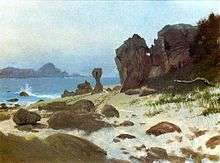 Albert Bierstadt, "Bay of Monterey", oil on paper, undated
Albert Bierstadt, "Bay of Monterey", oil on paper, undated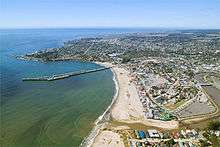 Aerial view of the north end of Monterey Bay at Santa Cruz
Aerial view of the north end of Monterey Bay at Santa Cruz
References
- Gudde, Erwin G. (1949). California Place Names. Berkeley, Calif.: University of California Press. p. 222. ASIN B000FMOPP4.
- Clark, Donald T. (1991). Monterey County Place Names. Carmel Valley, Calif.: Kestrel Press. p. 322. ISBN 978-1-880478-00-4.
- Wagner, Henry R. (1937). Cartography of the Northwest Coast of America to the Year 1800. Berkeley, Calif.: University of California Press. p. 398. ASIN B001K5A42S.
- "Monterey Canyon: Stunning deep-sea topography revealed | MBARI". www.mbari.org. Retrieved 2018-01-10.
Further reading
- Palumbi, Stephen R; Sotka, Carolyn (November 12, 2010). The Death and Life of Monterey Bay: A Story of Revival. Island Press. ISBN 978-1610911900.
External links
| Wikimedia Commons has media related to Monterey Bay. |

- Live Monterey Bay Web Cam
- Monterey Bay National Marine Sanctuary website